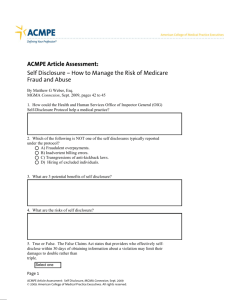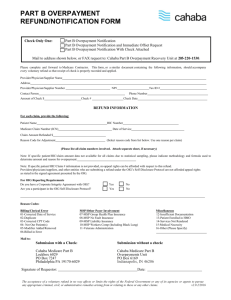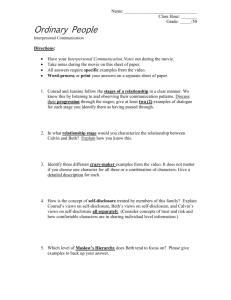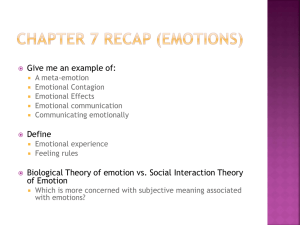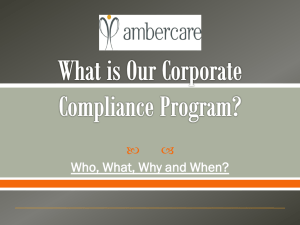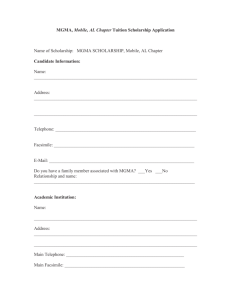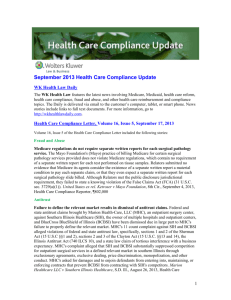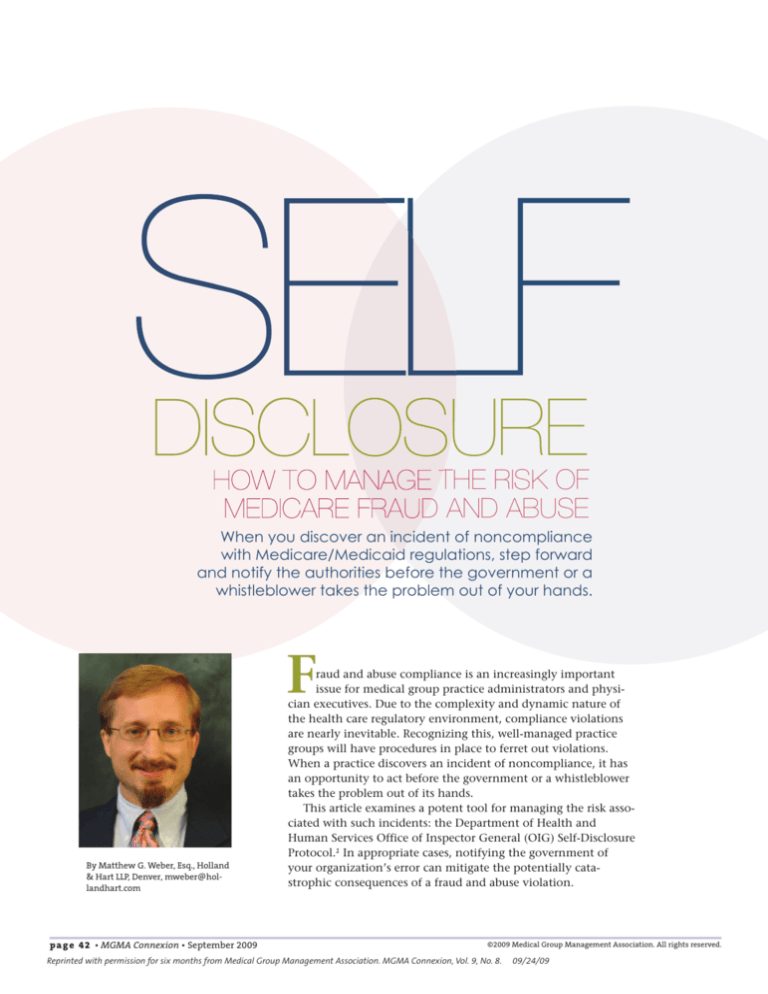
SELF
DISCLOSURE
HOW TO MANAGE THE RISK OF
MEDICARE FRAUD AND ABUSE
When you discover an incident of noncompliance
with Medicare/Medicaid regulations, step forward
and notify the authorities before the government or a
whistleblower takes the problem out of your hands.
F
By Matthew G. Weber, Esq., Holland
& Hart LLP, Denver, mweber@hollandhart.com
p a g e 4 2 • MGMA Connexion • September 2009
raud and abuse compliance is an increasingly important
issue for medical group practice administrators and physician executives. Due to the complexity and dynamic nature of
the health care regulatory environment, compliance violations
are nearly inevitable. Recognizing this, well-managed practice
groups will have procedures in place to ferret out violations.
When a practice discovers an incident of noncompliance, it has
an opportunity to act before the government or a whistleblower
takes the problem out of its hands.
This article examines a potent tool for managing the risk associated with such incidents: the Department of Health and
Human Services Office of Inspector General (OIG) Self-Disclosure
Protocol.1 In appropriate cases, notifying the government of
your organization’s error can mitigate the potentially catastrophic consequences of a fraud and abuse violation.
©2009 Medical Group Management Association. All rights reserved.
Reprinted with permission for six months from Medical Group Management Association. MGMA Connexion, Vol. 9, No. 8.
09/24/09
Risk Management
Pros, cons to disclosing your
group’s mistake
The OIG protocol is intended for matters
that may involve potential fraud against
federal health care programs. It’s not meant
to cover mere inadvertent billing errors or
Medicare overpayments, which can be handled through other avenues, such as reporting to the Medicare contractor. Nor is it
intended for Stark Act violations, unless the
same conduct implicates the Anti-Kickback
Act, as well.2 Most self-disclosures involve
fraudulent overpayments, billing/coding violations, transgressions of the antikickback
act or Stark law, or the hiring of excluded
individuals. Even when the protocol applies, the decision to use it requires careful
investigation, evaluation, judgment and the
assistance of legal counsel.
Self-disclosure has both benefits and
risks.
Benefits of self-disclosure
On the benefit side, the OIG encourages
self-disclosure, and it may be more lenient
toward providers who follow the protocol.
For instance, if the OIG settles the matter, it
may base its settlement offer on a financial
impact assessment at the lower end of the
available range by looking at antikickback
damages (based on the value of the improper payments or remuneration) rather
than Stark damages (based on the value of
improper claims).3 It may also reduce the
multiplier it applies to the financial impact
assessment.
Also, following the protocol may avoid
the presumptive imposition of a corporate
integrity agreement or corporate compliance agreement that could otherwise burden your practice with costly oversight
obligations for years to come.4
Self-disclosure gives your organization a
chance to gain control over the situation
and cast the disclosed incident in a manner
that avoids misunderstandings by the government.
Risks of self-disclosure
On the other hand, self-disclosure entails
substantial risks. The protocol provides no
guarantees of leniency, immunity or benefits. In fact, the OIG may deny all benefits if
it perceives that your practice has not followed the protocol in good faith or in a
timely manner. Further, resolving issues
through self-disclosure can be expensive
and disrupt daily operations and employee
morale. Making a self-disclosure can trigger
investigation by the OIG, other agencies or
potential civil litigants. Moreover, providing
information to the government may create
waiver issues related to the attorney-client
privilege and work-product protections.
In appropriate cases, notifying the government of your
organization’s error can mitigate the potentially catastrophic consequences of a
fraud and abuse violation.
Other disclosure considerations
Other issues may be relevant to the disclosure decision, including:
• The strength of the evidence of intent to
defraud. Is there evidence of recklessness
or deliberate indifference?;
• The likelihood of a whistleblower
coming forward;
• The strength of the compliance program;
• The likelihood of criminal exposure; and
• Whether disclosure should be made to
the OIG or another agency/entity.5
Make your self-disclosure decision in a
timely manner to avoid losing the benefits.
For example, the False Claims Act states
that providers who effectively self-disclose
within 30 days of obtaining information
about a violation may limit their damages
to double rather than triple.6
see
Self disclosure, p a g e
44
mgma.com
• Search: “fraud and abuse”
• Contact: MGMA Health Care
Consulting Group –
mgma.com/consulting
• Store: Item 6802 for the Compliance Guide for the Medical
Practice
©2009 Medical Group Management Association. All rights reserved.
MGMA Connexion • September 2009 • p a g e 4 3
Reprinted with permission for six months from Medical Group Management Association. MGMA Connexion, Vol. 9, No. 8.
09/24/09
Self disclosure
from page 43
What to do – Five steps
You need an action plan for your practice to
support the decision-making and self-reporting process. With the assistance of legal
counsel, design the plan around five steps:
A convincing audit is important to demonstrate that
• Define the scope of the trangression;
your group has remediated
• Preserve relevant documents;
the problem and eliminated
• Investigate;
• Remediate; and
• Audit.
Define the scope – To determine the scope
of the issue, your group’s legal counsel or
counsel’s delegate should interview the
source of the internal report and other central witnesses. Often, this initial effort uncovers additional allegations. This is helpful
to avoid the discovery of other issues after
the initial disclosure, necessitating supplemental disclosures. A close examination of
documents may also be necessary to better
understand the scope of the allegations.
Preserve relevant documents – You must secure relevant documents as soon as your organization receives notice that a federal
investigation may take place — or risk criminal prosecution.7 Cast a wide net: Preserve
both hard-copy and electronic files. Ensure
that e-mail and other electronic data are not
inadvertently destroyed through regular
purging cycles. In appropriate cases, qualified forensic experts may make copies of
your hard drives to preserve electronic evidence. Depending on the size of your practice, you may have to distribute a memo to
employees instructing them not to destroy
relevant documents and data.
Investigate – The OIG protocol requires a
complete investigation of a fraud-and-abuse
disclosure.8 A thorough investigation can be
costly, but it’s far better for your practice to
undertake that responsibility than to wait
for the government to conduct its own investigation. The investigation will usually
pick up where the initial “define the scope”
inquiry left off and then focus on the details of the incident. Anyone allegedly involved should not have a role in the
investigation, which should be directed by
legal counsel.
Attorneys who specialize in fraud-andp a g e 4 4 • MGMA Connexion • September 2009
the need for the OIG to
continue external oversight
through a corporate integrity agreement or corporate compliance
agreement.
abuse investigations follow procedures designed to increase the confidentiality, integrity and reliability of the process. For
instance, they compartmentalize information obtained in witness interviews to avoid
possible breaches of confidentiality and polluting witnesses’ memories with information from others. Seasoned lawyers will
advise your employees — sometimes called
“civil Miranda advisements” — to let them
know, among other things, that they represent only the practice, if that entity hired
the lawyers. In such cases, counsel does not
represent the employee. Employees’ cooperation is expected and they are to maintain
the confidentiality of interviews to protect
the practice’s attorney-client privilege. The
attorneys will explain that the privilege belongs to the practice and that the practice
has the right to waive the privilege and
share the information with others, including the government.
Remediate – Remediation is critical to successful self-disclosure. The facts of each case
will drive the remediation plan, but most
remedial efforts aim to:
• End the noncompliant conduct
(including taking appropriate
disciplinary action);
©2009 Medical Group Management Association. All rights reserved.
Reprinted with permission for six months from Medical Group Management Association. MGMA Connexion, Vol. 9, No. 8.
09/24/09
• Improve procedures, policies, controls
and systems; and
• Train members of the practice in
appropriate conduct.
Remediation may also include refunding
payments to the fiscal intermediary or others. The protocol, however, states that the
OIG should approve any such refunds.9
Audit – Taking remedial action alone is
not enough; your group also must demonstrate that the action was effective. An audit
will document the impact of the remediation. Depending on the circumstances, you
may want to consider hiring a consultant to
conduct the audit to provide the OIG with
an independent assessment. A convincing
audit is important to demonstrate that your
group has remediated the problem and
eliminated the need for the OIG to continue external oversight through a corporate integrity agreement or corporate
compliance agreement.
An effective tool against fraud and
abuse
As of mid-2008, the OIG protocol had accepted 379 disclosures of Medicare fraud
and abuse. Of those, 165 were resolved, returning more than $118 million to the
Medicare Trust Fund. Since then, the rate of
recovery has accelerated, with total recoveries most likely reaching or exceeding the
$200 million mark. With the additional
guidance provided in the OIG Open Letters
of April 24, 2006, and April 15, 2008, the
provider community appears increasingly
interested in using the protocol. Applied appropriately, self-disclosure offers an effective
tool to mitigate compliance risk for medical
groups confronting potential fraud and
abuse violations.
join the discussion: Has your organization voluntarily disclosed a fraud-and-abuse incident to the
OIG? Tell us at mgma.com/connexioncommunity or
connexion@mgma.com
Resolution
The self-disclosure process is not a speedy
one. Anecdotal evidence suggests that, in
the past, only about half the disclosures
were resolved within a year from filing. The
OIG announced its intention to resolve disclosures more promptly in its April 15,
2008, Open Letter to Providers. As part of
that initiative, the OIG established new
deadlines requiring more timely action by
those making disclosures.
Self-disclosure normally ends through
settlement. The size of the settlement depends on numerous factors, including
whether the financial impact on Medicare is
measured by the low or high end of the
range, the size of the multiplier applied to
the financial impact number and whether a
corporate integrity agreement is involved.
Also, depending on the allegations and the
scope of the release desired, agencies other
than the OIG may get involved in the settlement, which can affect the terms.
notes
1. Provider Self-Disclosure Protocol, 63 Fed. Reg. 58,339
(Oct. 30, 1998).
2. Open Letter to Health Care Providers, March 24,
2009, available at http://oig.hhs.gov/fraud/docs/
openletters/OpenLetter3-24-09.pdf (accessed
7/17/09).
3. Open Letter to Health Care Providers, April 24, 2006,
available at www.oig.hhs.gov/fraud/docs/openletters/Open%20Letter%20to%20Providers%202006.pd
f (last accessed 1/9/09).
4. Open Letter to Health Care Providers, April 15, 2008,
available at www.oig.hhs.gov/fraud/docs/openletters/OpenLetter4-15-08.pdf (last accessed 1/9/09).
5. This article is limited to the OIG protocol and does
not discuss self-reports to others such as fiscal intermediaries, the United States Attorney General’s office
or state Medicaid Fraud Control Units.
.
6. 31 U.S.C. § 3729(a)
7. 18 U.S.C. § 1519.
8. Open Letter to Health Care Providers, April 15, 2008.
9. See Protocol at 58,403.
©2009 Medical Group Management Association. All rights reserved.
MGMA Connexion • September 2009 • p a g e 4 5
Reprinted with permission for six months from Medical Group Management Association. MGMA Connexion, Vol. 9, No. 8.
09/24/09

